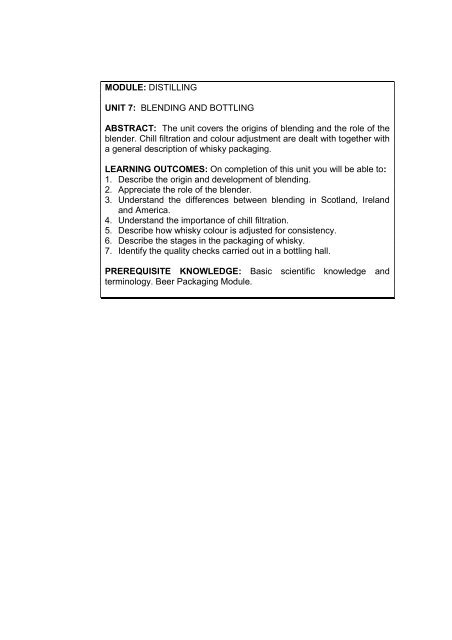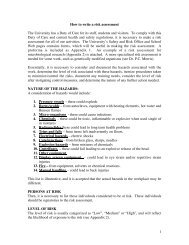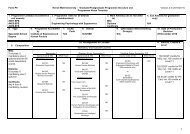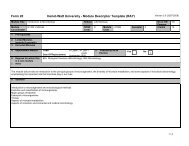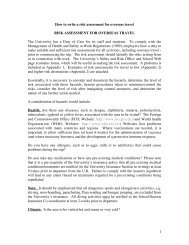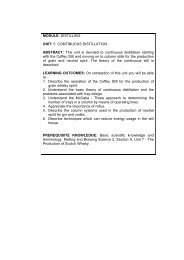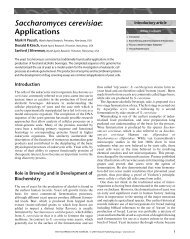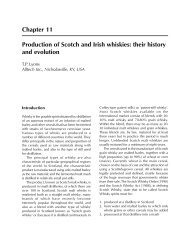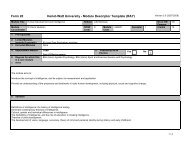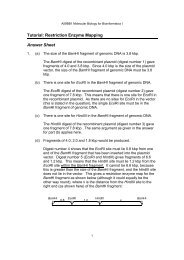MODULE: DISTILLING UNIT 7: BLENDING AND BOTTLING ...
MODULE: DISTILLING UNIT 7: BLENDING AND BOTTLING ...
MODULE: DISTILLING UNIT 7: BLENDING AND BOTTLING ...
Create successful ePaper yourself
Turn your PDF publications into a flip-book with our unique Google optimized e-Paper software.
<strong>MODULE</strong>: <strong>DISTILLING</strong><br />
<strong>UNIT</strong> 7: <strong>BLENDING</strong> <strong>AND</strong> <strong>BOTTLING</strong><br />
ABSTRACT: The unit covers the origins of blending and the role of the<br />
blender. Chill filtration and colour adjustment are dealt with together with<br />
a general description of whisky packaging.<br />
LEARNING OUTCOMES: On completion of this unit you will be able to:<br />
1. Describe the origin and development of blending.<br />
2. Appreciate the role of the blender.<br />
3. Understand the differences between blending in Scotland, Ireland<br />
and America.<br />
4. Understand the importance of chill filtration.<br />
5. Describe how whisky colour is adjusted for consistency.<br />
6. Describe the stages in the packaging of whisky.<br />
7. Identify the quality checks carried out in a bottling hall.<br />
PREREQUISITE KNOWLEDGE: Basic scientific knowledge<br />
terminology. Beer Packaging Module.<br />
and
Unit 7: Blending and Bottling<br />
<strong>UNIT</strong> 7 <strong>BLENDING</strong> <strong>AND</strong> <strong>BOTTLING</strong><br />
CONTENT<br />
7.1<br />
7.2<br />
7.3<br />
7.4<br />
7.5<br />
7.5.1<br />
7.5.2<br />
7.6<br />
7.6.1<br />
7.6.2<br />
7.6.3<br />
7.6.4<br />
7.6.5<br />
7.6.6<br />
7.6.7<br />
7.7<br />
7.8<br />
7.9<br />
Origins of Blending<br />
Categories of Whisky<br />
The Blender<br />
Blending in Scotland, Ireland, and the USA<br />
Blending and Processing<br />
Filtration<br />
Colour<br />
Bottling<br />
General<br />
Bottle De-palletising and Cleaning<br />
Filling<br />
Capping<br />
Labelling<br />
Carton Filling and Palletising<br />
Quality Checks<br />
Summary of Key Points<br />
Self Assessment Questions<br />
Self Assessment Answers<br />
Page<br />
3<br />
4<br />
5<br />
7<br />
8<br />
9<br />
10<br />
11<br />
11<br />
11<br />
11<br />
12<br />
13<br />
13<br />
13<br />
15<br />
16<br />
17<br />
© 2001 The International Centre for Brewing and Distilling 2
Unit 7: Blending and Bottling<br />
7 Blending and Bottling<br />
7.1 Origins of Blending<br />
Andrew Usher of Edinburgh is the man who is credited with being the<br />
first blender of malt and grain whisky. Although the date is disputed,<br />
1860 is the year usually associated with this development.<br />
It is interesting to know something of the background, which led up to<br />
this event. Grain whisky had arrived with the Coffey Still in 1830, but<br />
initially it was either sold as an alternative to malt whisky, or it was<br />
exported for rectification and gin production in England. In the 1850’s<br />
Andrew Usher had pioneered the craft of “vatting”, that is mixing malt<br />
whiskies from different aged distillations at the same distillery and as the<br />
agent for Glenlivet, he had been selling vatted malt for a number of<br />
years. He was, therefore, well placed to take advantage of a new law in<br />
1860 which permitted the blending, storage and racking of spirits from<br />
different distilleries in bonded warehouses without payment of duty.<br />
The blending of malt and grain whiskies was seen as a route to reducing<br />
the cost of a well flavoured whisky and achieving a consistency of its<br />
quality. But it also created a smoother and less aggressive drink and this<br />
enabled the product to rapidly capture markets outside Scotland.<br />
Usher was quickly followed by a number of other blenders with names,<br />
which remain familiar through brands, such as Walker, Dewar,<br />
Buchanan, and Bell. Blended whisky in the hands of these<br />
entrepreneurs spread in popularity around the globe.<br />
For a period the malt distillers were very hostile towards the blenders<br />
and the grain distillers, for they saw considerable threats to their<br />
livelihood. The malt distillers maintained that only their product merited<br />
the name “whisky”. In 1905 a successful prosecution was brought in the<br />
London Borough of Islington against two wine and spirits merchants for<br />
selling goods “not of the nature, substance, and quality demanded”; one<br />
of these products was a blended whisky produced from 90% grain and<br />
10% malt (a ratio which was not uncommon). This sounded alarm bells<br />
amongst the major blenders who lobbied the government to set up a<br />
Royal Commission to answer the question “what is whisky?” In 1908 the<br />
Commission, which ducked the contentious issue of the minimum<br />
proportion of malt in a blend, reported that whisky was “a spirit distilled<br />
from a wash saccharified by the diastase of malt”. This was seen as a<br />
victory for the blender and the grain whisky distiller.<br />
© 2001 The International Centre for Brewing and Distilling 3
Unit 7: Blending and Bottling<br />
The success of the industry has been, and still is, based on the global<br />
marketing of blends. Even today with an interest in single malts, which<br />
has been growing dramatically over the last fifteen years or so, blended<br />
whisky accounts for more than 90% of the sales of Scotch whisky.<br />
7.2 Categories of Whisky<br />
There are a number of categories of whisky which require explanation<br />
before we look at blending and bottling in detail.<br />
Cask Strength Single Malt Whisky is whisky which is bottled at the<br />
alcoholic strength with which the whisky emerges from the cask. The<br />
strength will vary with age and maturation conditions, but will usually be<br />
in the range 55 – 61% abv. A number of casks from the same distillery<br />
and vintage are mixed to produce a batch for bottling. Alternatively<br />
single casks may be bottled; each one will be slightly different and will<br />
be marketed as a limited edition. Many of these cask strength whiskies<br />
are not chill filtered and will develop a haze on the addition of water.<br />
Single Malt Whisky is simply the product of one malt distillery. It may, or<br />
may not, have an age statement on the bottle and this may well be<br />
determined by the age profile of the distillery stocks. Building up a<br />
market, for say a 16 year old, may not be money well spent if at some<br />
point in the future the age may have to be reduced because of shortage<br />
of stocks.<br />
Vatted Malt Whisky is a mixture of malts from a number of different<br />
distilleries. The bottles usually feature the term “pure malt” or “all malt”<br />
on the label.<br />
Blended Whisky is produced from grain and malt whiskies. Any number<br />
from 15 to 50 malts may be used with 2 to 4 grain whiskies. The<br />
formulas of blends are carefully guarded secrets known only to a few<br />
members of each company. However one can make some<br />
generalisations and divide the sector into three categories. At the bottom<br />
of the range are cheap supermarket own brands, which may be little<br />
more than 3 – 4 years old and contain only 10% of malt whisky.<br />
Standard blends would have older whiskies, perhaps in the range 5 – 8<br />
years old, and a malt whisky content in the range 30 – 45%. Deluxe<br />
blends will not only have a higher malt content, perhaps 60%, but will<br />
probably carry an age statement (12 year old is an age associated with<br />
some of the popular brands).<br />
© 2001 The International Centre for Brewing and Distilling 4
Unit 7: Blending and Bottling<br />
7.3 The Blender<br />
Although the early development of the blended whisky market was in the<br />
hands of entrepreneurs, who did not produce whisky, it was not long<br />
before the more successful ones secured some of their supplies by<br />
moving into distillery ownership. Today totally independent blenders are<br />
the exception with most of the major brands in the hands of spirits<br />
groups, which own distilleries.<br />
When considering blends it is obvious that even the largest groups do<br />
not own the range of distilleries they would need to produce their own<br />
blended brands. There has to be a considerable trade between the<br />
industry players, particularly in malt whiskies. The whisky producers will<br />
usually set up reciprocal deals where their malt, or grain, whisky is<br />
exchanged for the produce of another distiller – these deals are not<br />
necessarily on a one for one basis eg. two casks of Islay malt may be<br />
exchanged for three casks of Highland malt. Failing this they will buy the<br />
whiskies they need. The independent blenders have to buy all their<br />
requirements and, of course, they will be buying from their competitors<br />
in the retail markets. The deals will usually be for new make spirit but<br />
some stock gaps will inevitably have to be filled by the acquisition of<br />
matured spirit.<br />
KEY POINT: Most blends will contain a considerable number of malts<br />
(many contain 30 – 40) and therefore there has to be trading within<br />
the industry. Both malt and grain whiskies are exchanged with, or sold<br />
to, other distillers, although the blends they produce will compete<br />
with those of the initial producer.<br />
At the heart of this activity is the Master Blender. His, or her,<br />
responsibility is to ensure consistency of quality from batch to batch and<br />
to ensure that whisky of the right quality and age is available to achieve<br />
this.<br />
The blender will know the general requirements for each blend from past<br />
experience (precise recipes are rarely used). The first task is to ensure<br />
that whiskies of the right type and age will be available to meet future<br />
demands. This would be relatively straight forward if the time scale was<br />
about six months; but of course it is more likely to be six years and with<br />
that span there is a high likelihood of error so stock adjustments will<br />
have to be made as time passes. The blender is therefore involved in<br />
the process of converting the imprecise long term sales forecasts into<br />
production and/or purchasing plans and maturation programmes.<br />
© 2001 The International Centre for Brewing and Distilling 5
Unit 7: Blending and Bottling<br />
The art of blending is to take the light, sweet and blander grain whiskies<br />
and add flavour character to that background by the addition of malts.<br />
This is the general approach in all whisky blending around the world – a<br />
bland base spirit has flavouring spirits added to it. The real trick is to<br />
create a product, which in flavour terms is somehow more than the sum<br />
of its constituents. This synergy makes it difficult for even expert tasters<br />
to pick out individual malt components in a blend.<br />
KEY POINT: Blending to create all whisky types follows the pattern of<br />
adding spirits with distinct flavours to a blander base spirit. In the<br />
case of Scotch the malts provide the flavour and the grain whisky<br />
provides the lighter, blander base.<br />
Recipes are not the answer to blending, for whiskies will vary in<br />
availablity and they will change in character depending upon maturation<br />
conditions. Clearly with 30 – 40 malts in a blend, the impact of the<br />
absence of one is more easily overcome than it would be in a blend<br />
using only 15 - 20 malts. To help him in his task the blender will place<br />
distilleries into flavour groups based on similar blending attributes and<br />
into classes of varying quality (for example Highland malts, including<br />
Speyside, are often split into three classes with the top class<br />
commanding the highest value).<br />
Much of the blender’s time will be spent assessing samples by nosing.<br />
He must have a good nose and a good flavour memory. For nosing the<br />
sample is poured into a tulip shaped snifter and water is added to bring<br />
the alcohol content to a defined level (23% abv is commonly used). The<br />
glass is swirled and then the aroma is assessed. It is the volatile<br />
components which are examined and tasting is rarely a feature. Unless<br />
something really unusual has happened nosing will give an accurate<br />
assessment of quality – this is just as well for a blender may be required<br />
to assess 250 samples in one day!<br />
Alcohol strength influences congener distribution and thresholds. Below<br />
20% abv ethanol molecules are mono-dispersed in water; between 20<br />
and 57% abv the ethanol molecules aggregate. Dilution of a whisky to<br />
23% abv maximises volatiles release from the distillates, optimising<br />
sensory assessment.<br />
For each batch of a blend, the blender will select the casks he wants<br />
from the warehouses, and nose samples from each cask for approval.<br />
When the spirit has been blended, prior to bottling, samples will be<br />
nosed again and further additions of casks may be needed.<br />
© 2001 The International Centre for Brewing and Distilling 6
Unit 7: Blending and Bottling<br />
In some organisations the all embracing role of the Master Blender has<br />
become a team activity and indeed nosing responsibilities are usually<br />
shared among trained panellists.<br />
7.4 Blending in Scotland, Ireland and the USA<br />
Blends of Scotch whisky are derived from an industry with a huge<br />
portfolio of different whiskies (90 malt distilleries and 8 grain distilleries)<br />
and as has been said the more successful blends bring together<br />
whiskies from say 30 – 40 distilleries.<br />
Clearly this approach is not possible in Ireland or the USA, where the<br />
number of distilleries is quite small (Irish and American whiskies are<br />
described in Unit 11).<br />
In Ireland the blender not only has a small number of whiskey types<br />
available, but most of them will have been made in one distillery. The<br />
principle however is the same; light grain whiskey is blended with pot<br />
still and/or malt whiskies to give different flavour characteristics (pot still<br />
whiskey character is varied according to the mash bill, which may<br />
contain different ratios of malt to unmalted cereal). These variants plus<br />
those created by cask type and age are used to produce a surprising<br />
number of blends.<br />
In America blended whiskies will bring together grain whiskey, neutral<br />
grain spirit or light whiskey (light whiskey is collected between 80 and<br />
95% abv and matured for at least two years) as the blander ingredient<br />
and one, or both, of the more flavourful whiskey categories. These latter<br />
categories are, firstly, the whiskies produced from mash bills containing<br />
not less than 51% maize, rye or wheat (this includes bourbon) and,<br />
secondly, corn whiskey, which is made from a mash bill containing not<br />
less than 80% maize and matured in new or used uncharred oak casks.<br />
These flavourful whiskies serve the same purpose as the malts in<br />
Scotch blends; they are known as “straights” if matured for more than<br />
two years.<br />
American blends will often contain up to 35% straights and 65% light<br />
whiskies or spirits. As in Ireland the flavouring whiskies will usually have<br />
come from one distillery and be distinguished because of the mash bill<br />
and maturation variations.<br />
© 2001 The International Centre for Brewing and Distilling 7
Unit 7: Blending and Bottling<br />
7.5 Blending and Processing<br />
The casks selected for blending are disgorged over a stainless steel<br />
trough from which the whisky is pumped to a vat. The trough outlet is<br />
fitted with a mesh to retain any charcoal pieces or solids leaving the<br />
cask with the spirit.<br />
The spirit is thoroughly mixed in the blending vat, either with stirrers, or<br />
with air rousing, and samples are taken for nosing.<br />
The spirit strength is then reduced to the level required for bottling.<br />
Demineralised water is used to avoid any effect on flavour and the<br />
process is usually done in two stages, with sampling after the first<br />
addition of perhaps threequarters of the water volume, to ensure<br />
accuracy.<br />
There is one variation to this process, which is referred to as “marrying”.<br />
Marrying allows a period of rest in oak casks so that the blended<br />
components can adapt to each other. The practice has diminished but a<br />
number of distillers still emphasise its importance. The process was<br />
developed by A.J. Cameron, the Master Blender at Dewars in the early<br />
twentieth century. He would mix malts by region and then allow them a<br />
period of storage in oak casks before they went forward to be<br />
incorporated in a blend.<br />
KEY POINT: The process of marrying allows a period of rest in<br />
oak casks so that blended components can adapt to one another.<br />
While some distillers have been unable to detect any effect and<br />
have abandoned the practice, others continue to complicate their<br />
process in this way.<br />
Marrying is not limited to blends today. For example the Macallan single<br />
malt whisky is prepared by mixing the contents of 50 casks in a tank and<br />
then marrying this whisky by storing it in butts for a minimum of four<br />
weeks before bottling.<br />
7.5.1 Filtration<br />
The objective in filtering is to remove particulate material and eliminate<br />
the potential for haze formation. Almost all whiskies are subjected to<br />
chill filtration, the exceptions mainly coming in the specialist cask<br />
strength malt whisky bottlings.<br />
Cloudiness appears in two distinct forms, known as haze and floc.<br />
Whisky haze manifests itself when whisky is reduced in strength and<br />
© 2001 The International Centre for Brewing and Distilling 8
Unit 7: Blending and Bottling<br />
high molecular weight fatty acid esters, which are soluble in cask<br />
strength spirit, come out of solution. Storing the bottle at low<br />
temperature can bring about a similar effect. The whisky becomes<br />
opaque but its taste and nose are unaffected. Haze became an<br />
increasing problem to the industry in the 1950’s and filtration was found<br />
to be an acceptable alternative to educating a worldwide market that this<br />
was an expected occurrence and not an indication of a fault.<br />
Flocs are attributed to the precipitation of metallic salts of some of the<br />
organic acids present. The metallic ions, mainly calcium, come either<br />
from the water used for reducing or from filter sheets.<br />
To remove the haze forming material the whisky is chilled to between 0<br />
and 10°C (4.5°C is commonly used) and passed through cellulose filter<br />
pads impregnated with kieselguhr. The operation is carried out in a<br />
conventional plate and frame press. After filtration the whisky needs to<br />
be warmed to reach the filling temperature (about 20°C) and a second<br />
heat exchanger is used.<br />
KEY POINT: Chill filtration is carried out to remove hazes<br />
produced by fatty acid esters on dilution and/or chilling the<br />
bottle strength whisky. The filtration takes place between 0 –<br />
10°C and cellulose filter sheets impregnated with kieselguhr are<br />
used.<br />
The filter will usually have two sections, the first with roughing cellulose<br />
sheets to remove charcoal and other particulate matter, and the second<br />
with polishing sheets containing cellulose and kieselguhr. These<br />
polishing sheets do contain calcium and magnesium, which can cause<br />
formation of irreversible flocs, the metallic ions being precipitated out by<br />
oxalic acid. Although manufactures have reduced the levels of calcium<br />
and magnesium by acid washing, it is wise to subject new sheets to a<br />
recirculation cycle to ensure that any extraction of calcium and<br />
magnesium is diluted by the whole batch of whisky, rather than allow a<br />
high concentration in the first runnings to the bottling machine.<br />
Filtration is clearly a delicate step but it has been shown that the<br />
congener flavour balance is not affected. However there is a body of<br />
opinion which maintains that the removal of the fatty acid esters<br />
diminishes the mouthfeel sensation of a whisky.<br />
© 2001 The International Centre for Brewing and Distilling 9
Unit 7: Blending and Bottling<br />
7.5.2 Colour<br />
The casks used for maturation influence the colour of the mature spirit.<br />
Each batch prepared for bottling does therefore exhibit minor variations<br />
in colour, although these are reduced with batch size and similar mixes<br />
of cask.<br />
Springbank, a small distillery in Cambeltown, acknowledges that each<br />
batch of its much sought after single malt may vary in colour and states<br />
this on its label.<br />
Macallan, which is a sherry cask matured malt whisky, employs no<br />
colour correction. Here the distiller is required to match both flavour and<br />
colour solely by the selection of casks for each batch.<br />
KEY POINT: Food grade caramel is used to maintain a consistent<br />
level of colour in each whisky, though there are a few exceptions<br />
among the single malts.<br />
However these two distilleries are the exceptions rather than the rule<br />
and most distillers adjust colours so that all brand batches are identical.<br />
This is achieved by the addition of small amounts of food grade caramel.<br />
The caramel is supplied as a concentrated syrup which is diluted before<br />
addition. The colour of the blend is checked and the amount of caramel<br />
needed is calculated from reference tables. Usually about threequarters<br />
of the addition will be made, the blend roused, and then sampled again<br />
for colour, before the final addition is made. This is normally carried out<br />
as the spirit strength is being reduced. It is difficult to obtain meaningful<br />
figures for caramel addition, but the addition of one litre of diluted<br />
caramel to three thousand litres of whisky would approximate to a high<br />
level of addition.<br />
Whisky caramel is organoleptically inert at the levels used and does not<br />
impart any detectable aroma or taste.<br />
7.6 Bottling<br />
7.6.1 General<br />
The packaging of whisky follows similar stages to those involved in the<br />
bottling of beers. Clearly the absence of carbon dioxide simplifies the<br />
liquid handling side and the alcohol level in the product means that<br />
infection in the plant is not a problem. However extremely high<br />
© 2001 The International Centre for Brewing and Distilling 10
Unit 7: Blending and Bottling<br />
standards of labelling are demanded on what is a very expensive<br />
product, so filling speeds are much slower than would be found in a beer<br />
bottling hall.<br />
The process in a spirits packaging hall can be divided into the following<br />
steps;<br />
De-palletisation of bottles<br />
Bottle cleaning<br />
Bottle orientation<br />
Filling<br />
Capping<br />
Labelling<br />
Carton filling<br />
Carton palletising<br />
Pallet wraparound<br />
7.6.2 Bottle De-palletising and Cleaning<br />
Bottles are delivered in palletised loads with cardboard sheets<br />
separating the bottle layers. Automatic actions remove the packing<br />
sheets and feed the bottles onto a marshalling conveyor. The bottle flow<br />
is reduced to a single stream and the bottles enter a dry cleaning unit.<br />
The bottles are inverted on a rotary air jetting machine where they are<br />
given a blast of air through the neck. This removes any particulate<br />
material. The bottles are then restored to an upright position and moved<br />
on by a slat conveyor.<br />
7.6.3 Filling<br />
Before filling it may be necessary to put the bottles through an<br />
orientation unit. This is needed if the bottles are not round and there is a<br />
specific side for the label. Bottles are fed round a star wheel, which can<br />
check orientation by a physical characteristic of the bottle. The<br />
information collected passes to the rotary orientation unit, which will turn<br />
any bottle the star wheel instructs it to. All bottles then feed to the filler in<br />
the correct orientation.<br />
Filling is by gravity from a spirit holding tank in the top of the rotary filling<br />
unit. The filling level is controlled by the height of the filling tube. After<br />
filling a vacuum is applied so that any liquid above the bottom of the<br />
filling tube is sucked out of the bottle.<br />
Filling speeds vary with size of bottle. Speeds of 500 bottles/minute are<br />
available at the top of the range for miniatures and up to one litre<br />
© 2001 The International Centre for Brewing and Distilling 11
Unit 7: Blending and Bottling<br />
bottles, though 300 bottles/minute would be a more general speed of<br />
operation. These fillers would have about 45 filling heads. Large size<br />
bottles such as 4.5 litres might only be filled at a rate of 30<br />
bottles/minute.<br />
Overall line efficiency is of course affected by any slow down in the<br />
various stages. Thus although a filling unit may be rated at say 300<br />
bottles/minute the efficiency of the line is likely to be in the range of 65 –<br />
70% or 195 – 210 bottles/minute.<br />
Product temperature control is important as the bottle filler is operated<br />
volumetrically. Therefore the spirit needs accurate attemperation and<br />
this is achieved by passage through a plate heat exchanger after the<br />
filtration step (20°C is often specified).<br />
KEY POINT: Bottle filling is controlled volumetrically so it is<br />
important to control the temperature of the whisky going to<br />
filler.<br />
7.6.4 Capping<br />
Pilfer proof caps (the type where the consumer breaks a seal on<br />
opening the bottle for the first time) are generally used for whiskies and<br />
are usually made of aluminium. They must be fed to the capping<br />
machine the correct way up and this is achieved by means of an<br />
ingeniously simple device. Caps are fed into a hopper with a rotating<br />
base and at the circumference there are holes, which will take individual<br />
caps. As the caps revolve towards a collection point, they are subjected<br />
to a carefully controlled air jet; if the cap is upright it is blown out of the<br />
hole, so only inverted caps are collected and as they are fed to the<br />
capper they are turned to the desired orientation.<br />
When the cap is in place it is rolled to tighten the bottom section on to<br />
the bottle.<br />
For some markets devices to prevent refill are fitted into the bottle neck.<br />
These plastic units contain a ball, which acts like a non-return valve<br />
allowing liquid to flow out of the bottle when it is inverted but preventing<br />
liquid entering the bottle when it is the right way up. The units are fitted<br />
into the bottle cap when it is manufactured and when the cap is on the<br />
bottle it is given a sharp blow which pushes the plastic unit securely into<br />
the bottle neck.<br />
© 2001 The International Centre for Brewing and Distilling 12
Unit 7: Blending and Bottling<br />
Many of the malt whiskies are sold in cork stoppered bottles. Although<br />
these used to be inserted manually, this form of capping has now been<br />
automated.<br />
7.6.5 Labelling<br />
The adhesives used for labelling employ wet glue; the label is positioned<br />
on the bottle and brushed down as it passes round the labeller. It is<br />
quite common for spirits to have neck and back labels as well as the<br />
main product label, and all of these are applied on the rotary labeller.<br />
The main variant is self adhesive labels, which are used for special<br />
applications, such as foil and see through labels.<br />
7.6.6 Carton Filling and Palletising<br />
Cartons are delivered flat and are assembled and glued automatically<br />
using a hot melt glue. Divisions may be placed in the carton. The bottles<br />
are marshalled in the appropriate group (usually 12) and then lifted by<br />
suction heads and lowered into the carton. The carton lid is folded down<br />
and glued as it moves along the conveyor.<br />
The cartons are elevated and assembled automatically into the<br />
orientation required on a layer in a pallet. Pallets will normally be five<br />
layers high and contain about 70 cases. Sometimes spots of light glue<br />
are used to provide adhesion between layers.<br />
For extra stability the pallet load is stretchwrapped with a plastic film.<br />
7.6.7 Quality Checks<br />
Checks are carried out at various stages of the packaging operation. A<br />
typical selection is listed below.<br />
On – line checks<br />
the presence of label, cap and height of fill are detected by scanning<br />
the weight of filled cartons is checked by load cell conveyor<br />
Off – line checks are carried out on bottles withdraw from the line at 15<br />
minute intervals<br />
label positioning<br />
tightness of cap (torque measurement)<br />
product alcohol strength<br />
product pH<br />
© 2001 The International Centre for Brewing and Distilling 13
Unit 7: Blending and Bottling<br />
product turbidity<br />
bottle contents<br />
nosing for off flavours<br />
In terms of contents the requirement is that the batch average must be<br />
greater than the nominal contents and that each bottle must be within a<br />
specified tolerance (this differs from country to country).<br />
KEY POINT: The average contents of a batch must exceed the<br />
nominal contents and in addition the contents of each bottle<br />
must lie within defined tolerances.<br />
Traceability is an important aspect of packaging, and is covered in a<br />
number of ways. The back of each main label is printed with an<br />
individual number and these are recorded manually every 15 minutes.<br />
Each carton is ink jetted with a batch number, a case number and a<br />
product code. This makes it possible to trace any product bottle or<br />
carton to operations carried out within a 15 minute time span during the<br />
filling of a batch.<br />
© 2001 The International Centre for Brewing and Distilling 14
Unit 7: Blending and Bottling<br />
7.7 SUMMARY OF KEY POINTS<br />
1. Most blends will contain a considerable number of malts (many<br />
contain 30 – 40) and therefore there has to be trading within the<br />
industry. Both malt and grain whiskies are exchanged with, or sold<br />
to, other distillers although the blends they go into may well be in<br />
competition with those of the initial producer.<br />
2. Blending for all whisky types follows the pattern of adding spirits with<br />
distinct flavours to a blander base spirit. In the case of Scotch the<br />
malts provide the flavour and the grain whisky is the lighter, blander<br />
base.<br />
3. The process of marrying allows a period of rest in oak casks so that<br />
blended components can adapt to one another. While some distillers<br />
have been unable to detect any effect, others continue to complicate<br />
their process in this way.<br />
4. Chill filtration is carried out to remove hazes produced by fatty acid<br />
esters on dilution and/or chilling of bottle strength whisky. The<br />
filtration takes place between 0 – 10°C and cellulose filter sheets<br />
impregnated with kieselguhr are used.<br />
5. Food grade caramel is used to maintain a consistent level of colour<br />
in each whisky, though there are a few exceptions among the single<br />
malts.<br />
6. Bottle filling is operated volumetrically so it is important to control the<br />
temperature of the whisky going to the filler.<br />
7. The average contents of a batch must exceed the nominal<br />
contents and in addition the contents of each bottle must lie within<br />
defined tolerances.<br />
© 2001 The International Centre for Brewing and Distilling 15
Unit 7: Blending and Bottling<br />
7.8 SELF ASSESSMENT QUESTIONS<br />
Blending and bottling was a straight forward unit - so these questions<br />
you should not find too difficult. A good score is predicted!<br />
1. What is vatted malt whisky?<br />
2. Why would a deluxe blend cost more than a supermarket own label<br />
blend?<br />
3. Why is it difficult for production, purchasing and maturation<br />
programmes to anticipate sales?<br />
4. What are the equivalent of the malt and grain components of a<br />
Scotch whisky blend in blended whiskies from Ireland and USA?<br />
5. What is meant by “marrying” whiskies?<br />
6. Which compounds cause haze on dilution of whisky?<br />
7. From a marketing standpoint what are the alternatives to adding<br />
caramel to achieve colour consistency?<br />
8. After chill filtration why is it necessary to warm the whisky before<br />
bottling?<br />
9. Describe how product traceability may be achieved.<br />
7.9 SELF ASSESSMENT ANSWERS<br />
© 2001 The International Centre for Brewing and Distilling 16
Unit 7: Blending and Bottling<br />
Now to see whether you scored that expected 100%!<br />
1. What is vatted malt whisky?<br />
It is a mixture of malts from a number of different malt distilleries.<br />
2. Why would a deluxe blend cost more than a supermarket own label<br />
blend?<br />
The whiskies used in the supermarket own label blend would be much<br />
younger and the blend would contain a much lower proportion of the<br />
more expensive malt whiskies.<br />
3. Why is it difficult for production, purchasing and maturation<br />
programmes to anticipate sales?<br />
Production, purchasing (of new make whisky), and maturation decisions<br />
have to be made years before the year of sale. Sales forecasts made 5<br />
– 10 years ahead will have only one common feature – they will be<br />
wrong.<br />
4. What are the equivalent of the malt and grain components of a<br />
Scotch whisky blend in blended whiskies from Ireland and USA?<br />
Irish blends use grain whisky with the flavourful products of pot still<br />
and/or malt whisky.<br />
American blends use grain whisky, neutral spirit, or light whisky as the<br />
blander components and rye, wheat or corn whiskies as the flavourful<br />
components.<br />
5. What is meant by “marrying” whiskies?<br />
The marrying process allows a period of rest in oak casks between the<br />
blending and the bottling.<br />
6. Which compounds cause haze on dilution of whisky?<br />
Fatty acid esters.<br />
© 2001 The International Centre for Brewing and Distilling 17
Unit 7: Blending and Bottling<br />
7. From a marketing standpoint what are the alternatives to adding<br />
caramel to achieve colour consistency?<br />
Either accept that there may be slight colour differences between<br />
batches (and tell consumers why), or adjust colour solely by means of<br />
cask selection.<br />
8. After chill filtration why is it necessary to warm the whisky before<br />
bottling?<br />
Because bottle filling is governed by volumetric measures the<br />
temperature of the whisky will affect the quantity in the bottle. Whisky is<br />
heated to a controlled temperature, usually close to 20°C.<br />
9. Describe how product traceability may be achieved.<br />
Each label has an individual number on its back and these numbers are<br />
recorded at regular time intervals. Each carton has an individual number<br />
and a batch number and these too are recorded. It is therefore possible<br />
to detect the time period when a particular bottle was filled.<br />
© 2001 The International Centre for Brewing and Distilling 18


